
Brittonia,
vol 56 (3) - 260.274, 2004
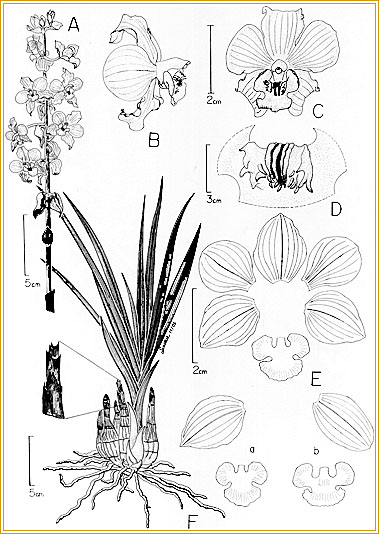
Fig.
18 |
Cyrtopodium
lamellaticallosum
A. Inflorescence.
B. Flower, side view.
C. Flower, frontal view.
D. Callus.
E. Perianth.
a - b. Variations in lateral sepals and lip morphology, from
different individuals of the same population.
F. Habit with almost fully developed leaves about 1-2 months
after flowering. The apex of a one year old pseudobulb showing
the remaining sheet of the leaves and the articulation pattern
is enlarged.
Drawn from Batista et al. 1262 by Simone C. Souza e Silva. |
Tipo: BRAZIL.
Minas Gerais, Município de Moeda, 24 Out. 2001, J.A.N.
Batista, L.B. Bianchetti, A. Salino, R.C. Mota & P.L. Viana
1262 (HOLÓTIPO: CEN; ISÓTIPOS: AMES, K, RB, SP).
Cyrtopodio
cristato Lindl. similis sed bracteis floralibus longioribus
et deflexis, petalis et sepalis brunneo-purpureis, labelli lilacino-purpureo
cum callo lamellato marginibus irregulariter dentatis praedito
differt.
Terrestrial herb. Roots many, whitish, glabrous. Pseudobulbs exposed
or occasionally partially buried, ovoid, acuminate, leafless from
the second year onwards, externally greenish, 5-11 x 1.4-2.4 cm.
Leaves at flowering 7-8, incompletely developed but already apparent,
11-23 x 0.6-1.4 cm, when fully developed 9-10, erect, coriaceous,
linear-lanceolate, the lowermost 1-2 sheath-like, the uppermost
8-9 16-35 x 1-1.8 cm, articulate 4.8-6.2 cm from the leaf base,
the apex acuminate. Inflorescence lateral, erect, usually simple,
occasionally with a lateral branch up to 13 cm long, lax, 19-35
cm, greenish to brownish green; peduncle 11-20 cm, the 1-2 sheathlike
bracts loosely adpressed, 1.5-3 cm long, frequently also with
1-2 pair of opposite bracts with abortive flowers; rachis 9-18
cm long; floral bracts deflexed, parallel and partially covering
the rachis, broad, ovate to ovate-lanceolate, occasionally opposite,
2-2.7 x 1.4-2 cm, brownish green, the apex acute, discreetly apiculate,
the margins undulate; ovary with pedicel 1.9-4.7 cm long, brownish
green. Flowers 10-15 per inflorescence, showy, discreetly sweet-scented.
Sepals reflexed in fully opened flowers, broadly lanceolate to
ovate or elliptical, 15-20 x 9-14 mm, dark brownish-purple, the
apex discreetly apiculate, the margin slightly undulate; lateral
sepals slightly oblique. Petals usually reflexed in fully opened
flowers, slightly concave, broadly obovate-oblong, 14-16 x 11-14
mm, brownish-purple, base lighter, the apex rounded, slightly
apiculate, the base attenuate, the margins entire, smooth. Lip
3-lobed, 10-12 mm long, 13-16 mm wide between the apices of the
side lobes when spread, the base unguiculate, ca. 2 mm long, yellow;
lateral lobes erect, not parallel, turned ca. 45o forward, reniform,
(4-)5.5 x 6-7(-8) mm, the base and center lilac, towards the borders
pinkish, the base constricted, the margins usually entire to occasionally
slightly serrate; callus prominent, formed by (4-)6(-8) parallel
lamellae, longitudinally extending from the base of the central
lobe to the unguicule, the central 2(-4) lamellae rounded, thicker,
yellow with the margins entire or slightly dentate, the outermost
2(-4) larger, slender, slightly spread, discreetly to profusely
irregularly dentate, dark lilac; isthmus separating the lateral
lobes from the central lobe discreet, ca. 1 mm long; central lobe,
reniform to lunate and then with the lateral edges auriculate,
4-5 x 9-11 mm, the base and central part dark lilac, apex slightly
orange, lateral edges yellowish, the lilac becoming faint orange
with aging, the apex rounded or very discreetly retuse when flattened,
the margin reflexed, slightly verrucose to completely smooth.
Column erect, slightly arcuate, trigonous, 9-10 mm long, base
yellowish white, middle lilac, towards the apex purple greenish;
column foot 2-3(-4) mm long, at the very end immediately before
the unguicule with a conspicuous dark brown stripe. Anther 3 x
2.5 mm, yellowish, apex green; pollinia 2, waxy, sulcate, ca.
1.3-1.5 x 0.8-1 mm, yellow, attached to a triangular stipe. Fruit
not known.
Etymology. The epithet refers to the lamellate callus with irregular
dentate margins, a very distinctive and unique characteristic
in the genus.
Additional specimens examined. BRAZIL. Minas Gerais: Ouro Preto,
10 Oct 1977 (fl), Badini s.n. (OUPR); Mun. Moeda, Nov 1988 (fl),
Martens s.n. (BHCB), Mun. Moeda, 18 Oct 1997 (fl), Salino 3610b
(BHCB) (p.p., with Cyrtopodium poecilum var. roseum).
| Cyrtopodium
lamellaticallosum |
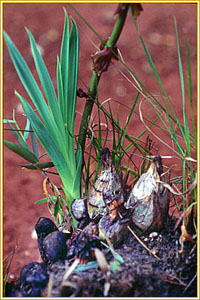 Fig.
19 Inflorescence.
Fig.
19 Inflorescence.
Note the large, deflexed, floral bracts partially covering
the rachis and the reflexed flower segments.
|
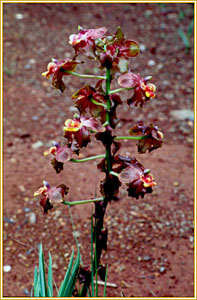 Fig.
20 Cyrtopodium lamellaticallosum.
Fig.
20 Cyrtopodium lamellaticallosum.
Pseudobulbs and young, incompletely developed leaves
at the time of flowering (October). |
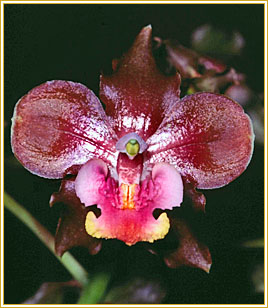 Fig. 21a Young, recently opened, flower, front view.
Fig. 21a Young, recently opened, flower, front view. |
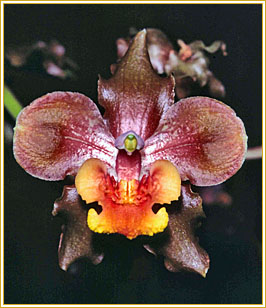 Fig. 21b Mature flower, front view.
Fig. 21b Mature flower, front view. |
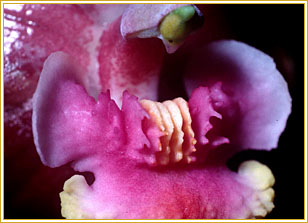 Fig. 22. Callus, lateral view. Note the
Fig. 22. Callus, lateral view. Note the
rounded lamellae with irregularly dentate margins.
|
Cyrtopodium
lamellaticallosum was found in the campo rupestre, on dark,
sandy-clay soil. This soil can retain water for a few days or
weeks during the rainy season, November to March, but dries out
completely during the dry season, May to September. Like most
other Cyrtopodium species of central and southeastern Brazil,
Cyrtopodium lamellaticallosum flowers during October
and November, the beginning of the rainy season. Similar to most
other Cyrtopodium species, a new vegetative shoot is formed
at the time of flowering (Fig. 20), but leaves only become fully
developed about two months later. Nonflowering specimens usually
have larger leaves which reach full development earlier. Plants
grow during the rainy season and are dormant during the dry season,
when they loose their leaves. Cyrtopodium lamellaticallosum
is sympatric with C. poecilum Rchb. f. & Warm., C.
eugenii Rchb. f., and C. pallidum Rchb. f. & Warm.
Flowering of Cyrtopodium lamellaticallosum and C. poecilum
is concurrent, while C. eugenii flowers earlier, from June
to September, and C. pallidum flowers later, from late
November to early January.
Flower color is variable and changes with age (Fig. 21a). The
lilac color turns to faint orange and the lip ends up with a yellowish
orange color in older flowers (Fig. 21b). Some color variants
with a completely lilac lip have also been observed. As in most
other species in the genus, the column foot has a conspicuous
dark spot at the base near the claw. The function of this spot
is unknown; it might facilitate pollination.
Cyrtopodium lamellaticallosum is a very distinct species;
it is not clear which species is most closely related to it. In
overall aspect, with the small, exposed pseudobulbs (Fig. 20)
and the usually simple inflorescence (Fig. 19), C. lamellaticallosum
(particularly dried specimens), somewhat resembles Cyrtopodium
cristatum Lindl. However, C. lamellaticallosum can
easily be distinguished by the usually slightly larger flowers,
the larger and deflexed floral bracts, the brownish purple sepals
and petals, and the lamellate callus with irregularly dentate
margins (Fig. 22). Lamellate calli are uncommon in the genus and
only C. blanchetii Rchb.f. and C. hatschbachii Pabst,
share this characteristic.
| |
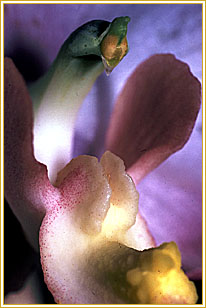
Fig. 24. Cyrtopodium hatschbachii.
Detail of the lip and callus.. |
|
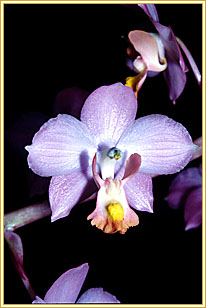
Fig. 26. Cyrtopodium hatschbachii. Flower. |
| |
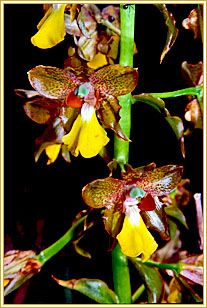
Fig. 25. Cyrtopodium blanchetii. Flowers |
|
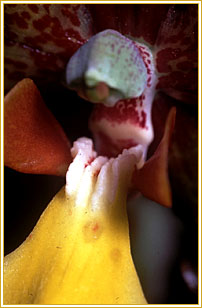
Fig. 23. Cyrtopodium blanchetii.
Detail of the lip and callus.. |
In C. blanchetii, the overall aspect of the callus, particularly
of the central lamella, is similar to that of C. lamellaticallosum;
in C. blanchetii there are always four lamellae, but are
frequently less prominent, more elongated, and less rounded, and
have margins that are entire or slightly irregular (Fig. 23).
In C. hatschbachii, there are just two lamellae, which
are larger, farther apart, and rounded, with smooth, sometimes
slightly undulate margins (Fig. 24). Beyond these differences
in the callus, Cyrtopodium blanchetti is usually from typical
cerrado; has the pseudobulbs completely buried; petals and sepals
spotted brown over a greenish background; lateral lobes of the
lip spathulate, brownish; and the midlobe obovate-subrhombiform,
yellow (Fig. 25). Cyrtopodium hatschbachii is from permanently
wet areas; has larger pseudobulbs, 8-21 x 2.5-5 cm; the sepals
and petals completely pink; and the lateral lobes of the lip elliptical
and subfalcate (Fig. 26).s (Fig. 26).
Cyrtopodium lamellaticallosum is a rare species. It is
known from just two localities at the southernmost Serra do Espinhaço
in central Minas Gerais state. This species might be expected
to occur at other sites or on other mountains in the Espinhaço
range.

Brittonia, vol 56 (3) - 260.274, 2004
Brittonia, vol 56 (3) - 260.274, 2004
Type.
BRAZIL. Minas Gerais, Município de Moeda, 24 Oct 2001,
J. A. N. Batista, L. B. Bianchetti, A. Salino, R. C. Mota &
P. L. Viana 1261 (HOLOTYPE: CEN; ISOTYPE: BHCB).
A
varietate typica floribus fragrantibus et labelli lobis lateralibus
roseis et marginibus lobi centralis roseis differe.
Etymology: The epithet refers to the pink margins of the central
lobe and pink lateral lobes of the lip.
Additional specimen examined. BRAZIL. Minas Gerais: Mun. of Moeda,
18 Oct 1997 (fl), Salino 3610b (BHCB) (p.p., with C. lamellaticallosum).
| Cyrtopodium
poecilum var. roseum |
|
|
|
| Fig.
27a.
Flower |
Fig.
27b.
Flower |
Fig.
27c.
Detail of the lip and callus. |
| Cyrtopodium
poecilum var. poecilum |
| |
|
|
Fig.
28a
Flower |
Fig.
28b
Flower |
Fig.
28c
Flower |
Cyrtopodium
poecilum var. roseum is morphologically identical to
C. poecilum var. poecilum in vegetative and most
floral characters. Both have mature pseudobulbs that are small,
externally reddish-purple, and completely buried; large and broad
leaves; a simple to 3-branched inflorescence; and sepals and petals
profusely spotted brownish purple over a greenish background.
The principal difference is the color of the lateral lobes and
margins of the central lobe of the labellum, which are pink in
the new variety (Figs. 27a-c) and brownish, reddish brown or reddish
purple in C. poecilum var. poecilum (Figs. 28a-d).
All specimens of C. poecilum var. poecilum that
we have examined in the Distrito Federal have a discreet but unpleasant
smell somewhat resembling rancid butter, C. poecilum var.
roseum has a slightly sweet scent. This difference in flower
scent may attract different pollinators. The pollinators and pollination
mechanisms of C. poecilum are unknown.
The holotype of C. poecilum var. poecilum is from
Lagoa Santa, central Minas Gerais, which is closer to the Municipality
of Moeda than to the Distrito Federal, where we have collected
more intensively and where we have found most of the material
we have examined in situ. However, examination of the original
description (Reichenbach, 1881) and original illustration (Warming,
1884) of C. poecilum revealed that the color pattern of
the type material matches the specimens from the Distrito Federal.
The specimens from the Municipality of Moeda with a distinct color
pattern are considered here as a color variant. In the Distrito
Federal, C. poecilum var. poecilum occurs preferentially
on deep red clay latosol in typical cerrado or campo sujo and
campo limpo vegetation. In the Municipality of Moeda, the variety
was found growing on dark, sandy clay soil in campo rupestre vegetation,
where it grew close to C. lamellaticallosum and C. pallidum.
Both varieties of C. poecilum var. poecilum flower
mainly in October and flowering is enhanced by fire. A visit to
the Municipality of Moeda in one year revealed no specimens in
flower, whereas in the next year, after the area had burned, a
great number of flowering specimens were observed..
In general, color variants are better treated as forms rather
than as varieties. However, for C. poecilum var. roseum,
the color variation seems to be clearly fixed in the population,
as most of the individuals had this character. Within this color
variant, some differences in shade have been observed, e.g., a
more or less intense shade of pink, particularly in relation to
the margins of the central lobe, or a fading of the pink in older
flowers, rendering the lip somewhat dull and discolored.
Acknowledgments
The authors thank Alexandre Salino for helping locate C. lamellaticallosum
in the field and Julio Lombardi for the loan of material from
BHCB. We also thank the curators of HB, HRCB, HUFU, IBGE, MBM,
OUPR, R, SP, SPF, UB and UEC for loans or access to their collections;
Simone C. Souza e Silva for preparing the illustrations; Tarciso
Filgueiras for the Latin diagnoses; and Stephen Hyslop for reviewing
the English. Gustavo Romero and Fábio de Barros read earlier
versions of the manuscript and provided several helpful suggestions.
Literature Cited
Batista,
J. A. N. & L. B. Bianchetti. 2001. Cyrtopodium linearifolium
(Orchidaceae): a new species from central Brazil. Lindleyana
16: 226-230.
Bianchetti,
L. B. & J. A. N. Batista. 2000. Cyrtopodium latifolium
(Orchidaceae): a new species from central Brazil. Lindleyana 15:
222-226.
Cribb,
P. & A. Toscano de Brito. 1996. Introduction and history.
Pages 23–32. In: S. Sprunger, editors. Iconographie des
orchidées du Brésil/João Barbosa Rodriguez.
Vol 1. Illustrations. Friedrich Reinhardt Verlag, Basle, Switzerland.
Greuter,
W., J. McNeill, F.R. Barrie, H.M. Burdet, V. Demoulin, T.S. Filgueiras,
D.H. Nicolson, P.C. Silva, J.E. Skog, P. Trehane, N.J. Turland
& D.L. Hawksworth (Eds.) 2000. International Code of Botanical
Nomenclature (Saint Louis Code) Regnum Veg. v. 138. Koeltz Scientific
Books, Königstein.
Menezes,
L. C. 1995. Novas orquídeas brasileiras (New Brazilian
orchids). Boletim CAOB 6: 8-13.
Menezes,
L. C. 2000. Genus Cyrtopodium: espécies brasileiras.
Ed. IBAMA, Brasília.
Reichenbach,
H. G. 1881. VII - Novitiae Orchidaceae Warmingianae. Cyrtopodium.
Otia Botanica Hamburgensia 2(1): 58-60.
Sprunger,
S., editor. 1996. Iconographie des orchidées du Brésil/João
Barbosa Rodriguez. Vol 1. Illustrations. Friedrich Reinhardt Verlag,
Basle, Switzerland.
Warming,
E. 1884. Symbolae ad floram Brasiliae centralis cognoscendam,
Part. 30. Orchideae 2. Videnskabelige Meddelelser fra den naturhistoriske
Forening i kjöbenhavn 5-8: 86-99.
Photos:
© João A. N. Batista
Any
kind of reproduction (print, digital or anyone) of any
type of material of this site: texts, layout, photos,
images and others - is strictly
forbidden without previous written permission of the authors.
Any solicitation or information should be done by the
e-mil: bo@sergioaraujo.com |
|